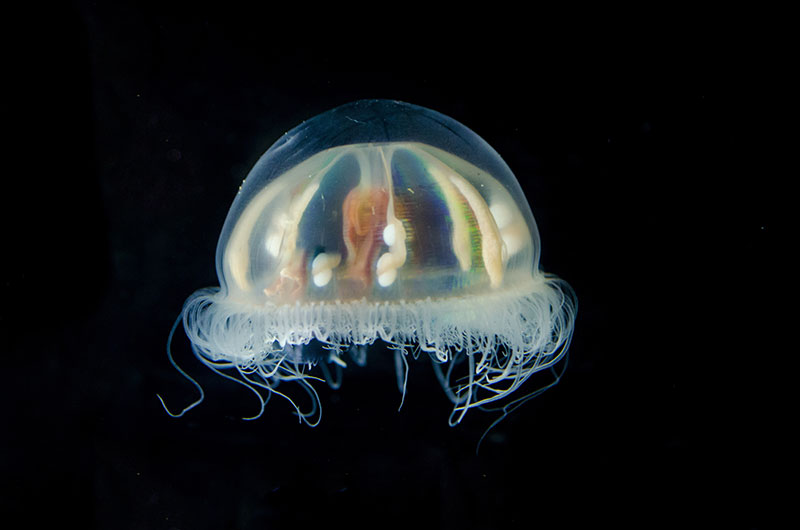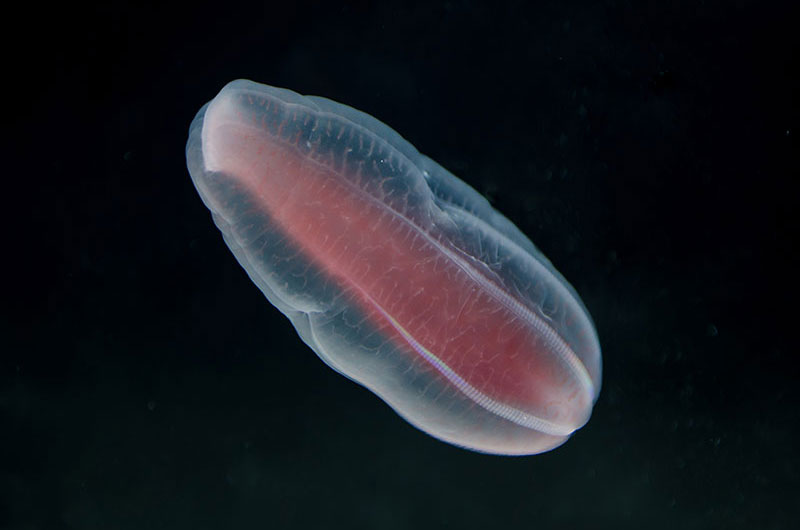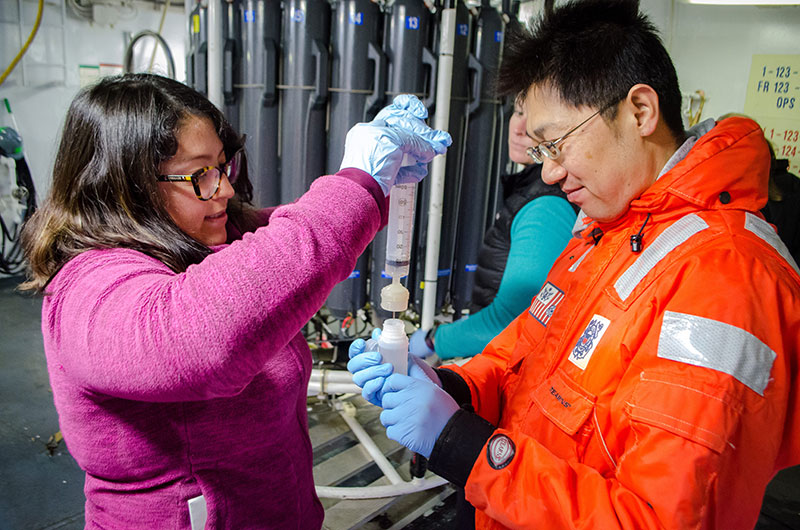
By Heidi Michelle Mendoza-Islas, Volunteer, University of Alaska Fairbanks
August 2, 2016

Heidi Mendoza-Islas checks out a jellyfish that was collected by the ROV. Image courtesy of Caitlin Bailey, GFOE, The Hidden Ocean 2016: Chukchi Borderlands. Download larger version (3.8 MB).
I am very passionate about jellyfish, and for a long time I have been wondering if there are jellies in the poles. If so, how do they survive? Looking for answers, I found a paper about remotely operated vehicle (ROV) expeditions researching jellyfish. And now here I am, on a six-week long expedition on an icebreaker.
My name is Heidi, I am part of the “Pelagic Team” on this Healy expedition. I like gelatinous zooplankton due to the fact that they are extraordinary animals. Despite their simple shape and aqueous consistency, they still have the ability to withstand hundreds of atmospheres of pressure, allowing them to extend their distribution even to the depths of the ocean. Gelatinous zooplankton do not have a brain, eyes, claws, or teeth. However, they are voracious predators and play an important roll in the food chain.
Our team is composed of people from different parts of the world: Japan, Australia, Canada, Taiwan, United States, and Mexico. We are researching life in the depths of the Arctic Ocean with the help of the ROV and Hydrobios multinet. Our deepest sample was from 2,000 meters under the sea surface, where we found species unknown to science. Even more exciting to me, the deeper we explore the more we find extraordinary animals with novel body shapes and life cycles.

This jellyfish is Benthocodon hyalinus and is found in the water column throughout the Pacific Ocean, from the Arctic Ocean to Antarctica. This specimen was collected by the Global Explorer ROV. Image courtesy of Caitlin Bailey, GFOE, The Hidden Ocean 2016: Chukchi Borderlands. Download larger version (jpg, 2.1 MB).

The Beroe abyssicola is a species of comb jelly that the Global Explorer ROV collected during the expedition. Image courtesy of Caitlin Bailey, GFOE, The Hidden Ocean 2016: Chukchi Borderlands. Download larger version (jpg, 1.4 MB).
As we view the ROV video feed in real-time on the ship, we see ctenophores projecting colored lights like space ships; siphonophores floating with hundreds of sparkling tentacles, cascading from each other; and Narchomedusae, Trachimedusae and Scyphomedusae in multiple colors and shapes.
Frequently, I am asked what it is like to work on an international team with respect to communication or decision making. For me, academic and cultural diversity enrich our team in both personal and professional ways. Different styles of work allow for a diverse set of ideas, which benefits our research. Finally, I have discovered that the universality of science is reflected in a single language, a primary objective, and a unique team.

Heidi Mendoza-Islas and Atsushi Yamaguchi, from Hokkaido University, filter seawater collected from the CTD. Image courtesy of Caitlin Bailey, GFOE, The Hidden Ocean 2016: Chukchi Borderlands. Download larger version (4.1 MB).
[Spanish Language Version]
Soy una apasionada de las medusas, desde hace tiempo me había estado preguntando ¿habrá medusas en los polos? Y si es así ¿cómo hacen ellas para sobrevivir? Buscando información me encontré con un artículo que hablaba sobre expediciones en el Ártico en busca de medusas con ayuda de ROVs. Y heme aquí, a un mes de expedición sobre un barco rompehielos.
Mi nombre es Heidi, soy parte del “Equipo Pelágico” en ésta expedición abordo de Healy. Me gusta el zooplancton gelatinoso debido a que son animales extraordinarios, a pesar de su simple estructura y consistencia acuosa pueden soportar cientos de atmósferas de presión, mismo que les permite extender su distribución incluso en las profundidades del océano. No poseen cerebro, ojos, garras, ni dientes, sin embargo se les considera como depredadores voraces jugando un roll importante en la cadena alimenticia.
Nuestro equipo está conformado por integrantes provenientes de diferentes partes del mundo, Japón, Australia, Canadá, Taiwan, EUA, y México. Buscamos vida en las profundidades del Océano Ártico con ayuda de ROV e Hydrobios multinet. Nuestro muestreo más profundo fue a más de 2000m bajo la superficie del océano, en el cual pudimos observar especies que nunca antes nadie había visto. A mi parecer, mientras más profundo se explora en el océano más interesantes son los animales que se encuentran, tanto en forma como en ciclos de vida. Cuando estamos viendo los videos en tiempo real que el ROV nos proporciona podemos apreciar criaturas sorprendentes, ctenoforos proyectando luces de colores como si fuesen naves espaciales; sifonóforos flotando con cientos de tentáculos iluminados, pendiendo uno del otro; Narcomedusas, Trachymedusas y Scyphomedusas todas en multiples colores y formas.
A menudo me preguntan cómo es trabajar con un equipo internacional, el sí tenemos problemas al comunicarnos o al tomar decisiones. Pero más bien pienso que la diversidad académica y cultural de los integrantes enriquece al equipo en distintas formas, tanto en el ámbito personal como en el laboral. Favoreciendo a la investigación con un conjunto diversificado de ideas provenientes de los diferentes estilos de trabajo. Para finalmente discernir que la universalidad de la ciencia se refleja en un solo lenguaje, en un objetivo principal y en un único equipo.